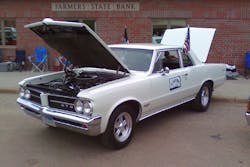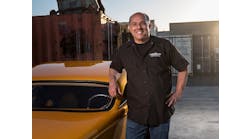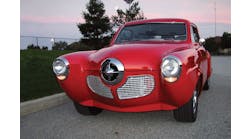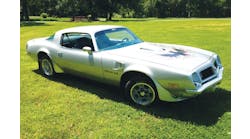Boyd Thiel’s home in Chamberlain, S.D., is known around town as the “goat farm.”
Not because he has goats—at least not the furry, hoofed ones that bleat. His are the two-door, tire-shredding types that make more of a roar—the goats more commonly known as Pontiac GTOs.
Thiel, who owns Thiel’s Collision Center in his hometown, has a sweet spot for the cars, which kicked off the muscle era in 1964 and took on the nickname “goat” in reference to the loose pronunciation of “GTO.” He owns one from that inaugural year, which he saved from slow destruction and laboriously returned to pristine condition with the help of his family.
The opportunity to buy this car came in 1983, when a customer with a ’64 GTO that wouldn’t start called Thiel to his home for an estimate. The car was rough. It had been sideswiped and had significant damage to the rear passenger-side fender. Plus the owner said the transmission was going out.
Thiel knew right away he wanted to own the car. He wanted it even more after hearing its history. A soldier stationed in Vietnam ordered the car brand new, Thiel was told. It waited for him on the showroom floor, but the buyer never made it home.
The man who ultimately purchased it, the same one who called Thiel, was also a military veteran who had served in the Air Force. Thiel, a veteran himself, was intrigued by the car’s military story, and he bought it for $600.
“It was sentimental to him,” Thiel says of the owner. “He didn’t want to see it scrapped.”
Luckily for the seller, that’s the opposite of what Thiel had in mind. The car did sit outside his shop for eight years before he could get to it, since he was married and had two children in addition to running the business.
“That was more important at the time,” he says.
But in 1991, after doing a few other classic restorations for customers, Thiel decided it was time to do his own. He completely stripped the GTO apart for a frame-off, rotisserie restoration.
The work involved replacing the lower quarter panels and trunk floor, hammering out a few dents, stripping the faded blue paint and spraying the car in its factory Cameo Ivory. The interior upholstery was replaced and the original 389-cubic-inch engine was rebuilt, bored .030 over and souped up with an aluminum intake and headers. The four-speed manual transmission was also rebuilt.
He scrounged swap meets for parts and fabricated his own when he had to. It was a tedious two-year effort that took up all of Thiel’s spare time.
The result was a better-than-new GTO, which has won numerous awards at area car shows and serves as a marketing tool for the body shop.
“It has helped my business because I think people see the quality of the work we do,” he says.
Thiel says his shop has restored about 20 classic cars since the GTO and it’s turned into a fun side business. His 6,000-square-foot shop, which has six employees, repairs about 20 cars a week and makes $750,000 annually, has also built a strong relationship with the Pioneer Auto Museum in Murdo, S.D., which displays several cars restored by Thiel’s shop.
He even earned a new GTO, a ’67, from the museum for restoring one of its vehicles. Thiel added to that with a brand-new GTO in 2004, before the model and the make became history. The restoration work isn’t really profitable, he says, but it’s more about the enjoyment he gets out of the end result.
“In a small town like this,” he says, “when somebody says they need a car restored, how can you say no?”




